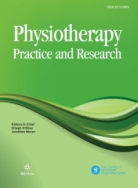Authors: Theobald, G | Parry, S | Richards, J | Thewlis, D | Tootill, I | Selfe, J
Article Type:
Research Article
Abstract:
Background: Little work has been undertaken on the biomechanical effects of patellofemoral taping and bracing in cycling. Objective: The purpose of the study was to assess the three-dimensional movement of the knee joint at different levels of resistance, across four treatment conditions, in experienced cyclists and discuss the clinical implications of the findings. Method: 15 healthy male subjects were asked to conduct four separate tests at three separate resistances on a static trainer. Each test used a different treatment modality. The order of testing was randomised a) no intervention, b) placebo patella taping, c) a patellofemoral brace, d) McConnell patella
…taping. Kinematic data were collected using a 10 camera ProReflex motion analysis system. Reflective markers were placed on the foot, shank, thigh and pelvis using the CAST technique. Results: A repeated measures two-way ANOVA test was performed together with posthoc Pairwise comparison with Bonferroni adjustment to examine the difference in three dimensional movement under the different conditions. Results (small significant differences) were presented in ROM tables for clinical application and relevance. Extension (1-2 p=0.002, 1-3 p=0.003, 2-3 p=0.004). Coronal plane between brace and neutral taping (p=0.033) also between resistances 1 & 3 and 2 & 3 (p=0.035, p=0.011). Transverse plane (p=0.028) between Brace and McConnell taping. Conclusion: If changes in the cycling movement patterns are required in clinical treatment, then taping or bracing may possibly affect this. However, a full understanding of an individual's biomechanical movement and cycling position is required as generic adaptations that do not take into account position, cadence, skin/fabric movement and power, and may be counterproductive. This study provides some initial understanding of the possible effects of bracing and taping in experienced cyclists, the application of taping may alter the biomechanics of the cycling action. Taping seems to initiate changes in ROM but as yet it is unclear as to its implication with respect to pain reduction. This study also helps us to understand that bracing is both impractical and any resultant changes during cycling are unlikely to be measurable.
Show more
Keywords: Patellofemoral Pain, Cycling knee pain, Biomechanics, Cycling, anterior knee pain
DOI: 10.3233/PPR-2012-33104
Citation: Physiotherapy Practice and Research,
vol. 33, no. 1, pp. 16-21, 2012
Price: EUR 27.50





